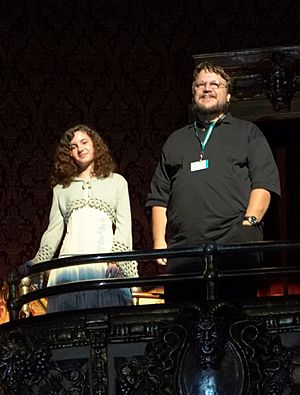Pan's Labyrinth facts for kids
Quick facts for kids Pan's Labyrinth |
|
|---|---|
| Directed by | Guillermo del Toro |
| Produced by |
|
| Written by | Guillermo del Toro |
| Narrated by | Pablo Adán |
| Starring |
|
| Music by | Javier Navarrete |
| Cinematography | Guillermo Navarro |
| Editing by | Bernat Vilaplana |
| Distributed by | Warner Bros. (Spain) Picturehouse (US) |
| Release date(s) | 27 May 2006 (Cannes) 11 October 2006 (Spain) 20 October 2006 (Mexico) |
| Running time | 119 minutes |
| Country |
|
| Language | Spanish |
| Budget | $19 million |
| Money made | $83.3 million |
Pan's Labyrinth (in Spanish: El laberinto del fauno) is a fantasy movie from Spain and Mexico. It was written and directed by the famous Mexican filmmaker Guillermo del Toro. This movie won several important awards, including three Academy Awards.
The story of Pan's Labyrinth happens in two different places at the same time. This is called a "dual setting." One part of the story is set in the "real world" in Spain during 1944. The other part takes place in a secret "fantasy world" that a young girl named Ofelia discovers.
Contents
Exploring the Story and Settings
This movie tells the story of Ofelia, a young girl who moves with her pregnant mother to a new home. Her stepfather, Captain Vidal, is a harsh officer from a political group called the Falange. He is hunting down guerrillas, who were fighters still resisting the government of Francisco Franco in Spain after the Spanish Civil War.
Ofelia's Magical Journey
In the fantasy world, Ofelia finds a mysterious labyrinth garden. There, she meets a strange creature called a faun. This faun gives her three dangerous tasks to complete. If she succeeds, she might discover her true destiny as a princess from a magical kingdom. As Ofelia tries to complete these tasks, she meets many other strange and magical creatures. The movie uses amazing make-up, puppets, and CGI to bring these creatures to life.
Real World vs. Fantasy World
The movie shows a strong contrast between the harsh reality of war and Ofelia's imaginative fantasy world. The real world is full of danger and sadness, while the fantasy world offers a way for Ofelia to escape and find hope. This helps viewers understand how imagination can be a powerful tool, especially in difficult times.
The Director's Vision
The director, Guillermo del Toro, has said that he sees Pan's Labyrinth as a modern fable. Fables are short stories that often teach a moral lesson. He was inspired by classic fairy tales when he created the movie.
Connecting to Other Stories
Del Toro also mentioned that this movie shares themes with his earlier film, The Devil's Backbone. Even though they are not direct sequels, they explore similar ideas about childhood, war, and the supernatural. The Spanish title of the movie, El laberinto del fauno, refers to a mythological creature called a faun from Roman mythology. The English title, Pan's Labyrinth, uses the name of the Greek god Pan to help English speakers understand it better. However, Del Toro has clarified that the faun in his movie is not the god Pan.
Awards and Recognition
Pan's Labyrinth was first shown at the 2006 Cannes Film Festival in May 2006. It later had a limited release in the United States and Canada in December 2006, before being released nationwide in January 2007.
The movie received many international awards for its unique story, amazing visuals, and strong performances. These awards include:
- Three Academy Awards (also known as the Oscars)
- The Ariel Award for Best Picture (Mexico's top film award)
- The 2007 Hugo Award for Best Dramatic Presentation, Long Form
See also
 In Spanish: El laberinto del fauno para niños
In Spanish: El laberinto del fauno para niños


